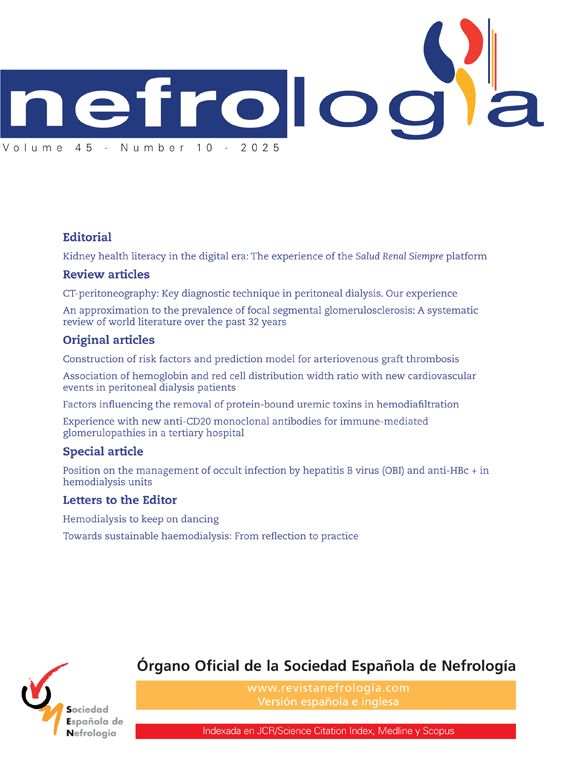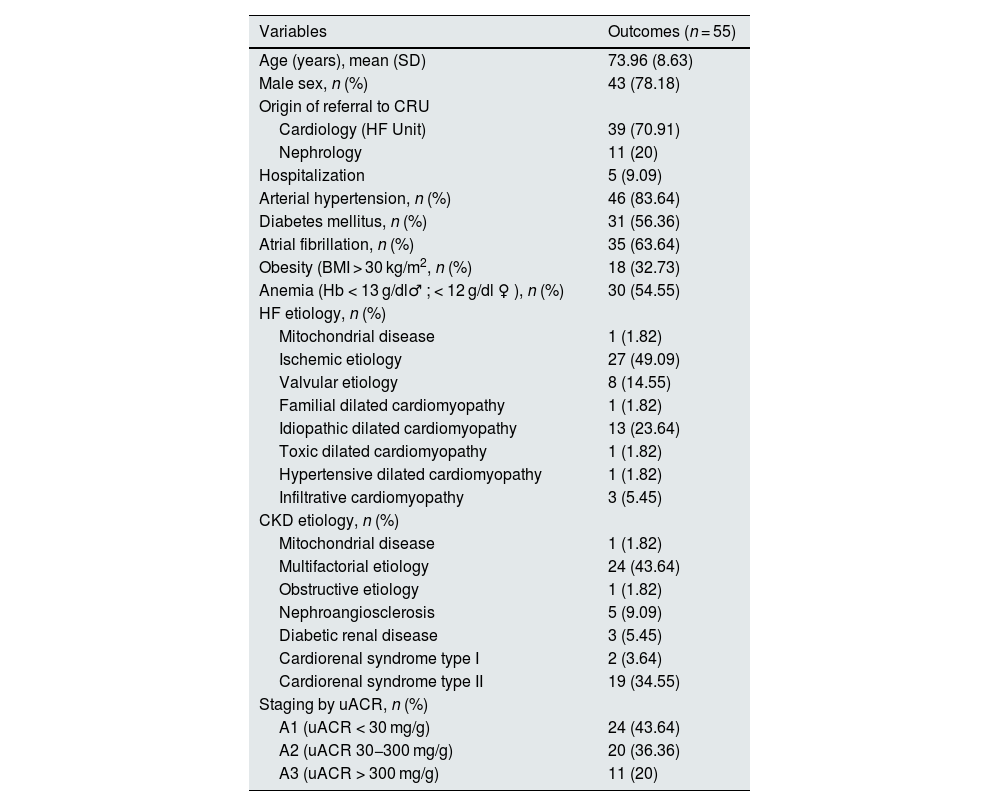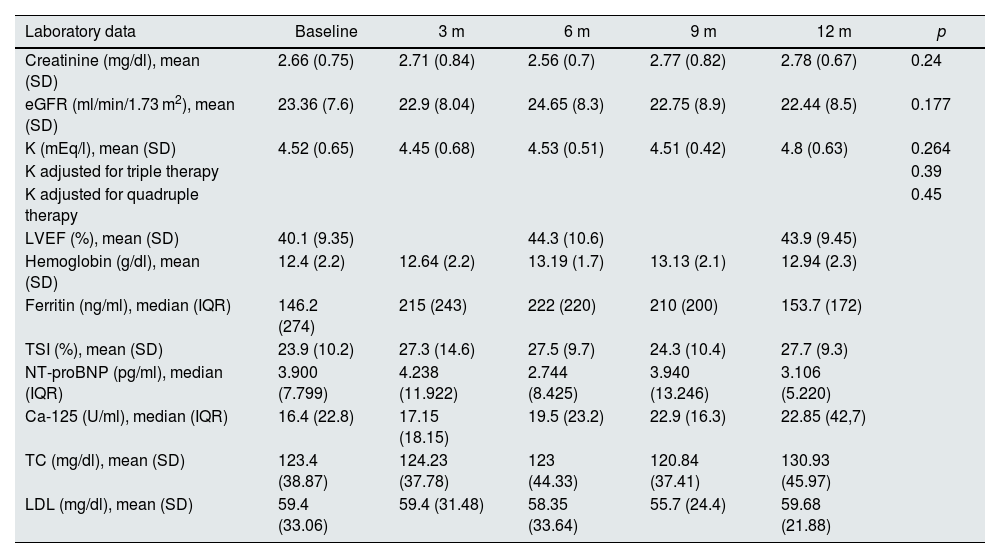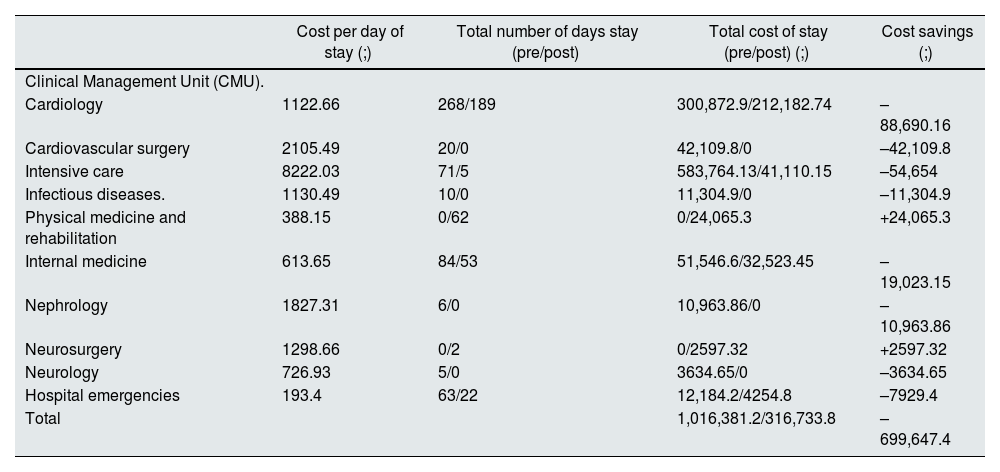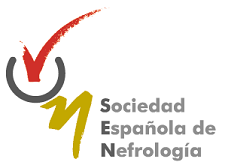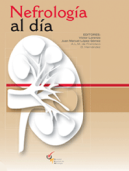Cardiorenal syndrome (CRS) reflects a bidirectional interaction between heart failure (HF) and chronic kidney disease (CKD), with high associated healthcare costs. Hospitalizations due to cardiovascular (CV) events, particularly for decompensated HF, represent most CKD-related costs. Cardiorenal units (CRU) emerge as an innovative strategy to address this complexity through a multidisciplinary approach. This study analyses the effectiveness and efficiency of CRUs.
Material and methodsObservational, longitudinal, prospective, and single-centre study using an adapted interrupted time-series design. Patients with advanced CKD (eGFR < 30 ml/min/1.73 m2) and HF with reduced left ventricular ejection fraction (LVEF) were included. Clinical, demographic, and care-related data were analysed during the year before and the year after enrollment. Economic costs were derived from healthcare resource consumption associated with hospital care activities.
ResultsIn 55 patients (mean age 73.9 ± 8.6 years; 78% male), a 65% reduction in emergency department visits (p = 0.0001) and a 60.5% reduction in hospitalizations (p = 0.0015) were observed. The economic analysis revealed cost savings of approximately ;700,000, with an average reduction of almost ;13,000 per patient/year. After inclusion in the CRU, there was an increased prescription of prognostic drugs, with no significant changes in serum potassium concentration (p = 0.26) and no evidence of renal function deterioration (pre-vs. post-eGFR: 23.36 ± 7.6 mg/dl vs. 22.44 ± 8.5 mg/dl; p = 0.17). A significant differential impact was observed in all healthcare outcomes, particularly among patients receiving quadruple therapy.
ConclusionCRUs emerge as effective and efficient models for the management of cardiorenal syndrome. Randomized controlled studies are needed to validate these findings and optimize healthcare policies.
El síndrome cardiorrenal (SCR) refleja una interacción bidireccional entre la insuficiencia cardíaca (IC) y la enfermedad renal crónica (ERC), con altos costes asistenciales asociados. Las hospitalizaciones por eventos cardiovasculares (CV), particularmente por IC descompensada, representan el coste mayoritario de la ERC. Las unidades cardiorrenales (UCR) surgen como una estrategia innovadora para abordar esta complejidad mediante un enfoque multidisciplinar. Este estudio analiza la efectividad y la eficiencia de las UCR.
Materiales y métodosEstudio observacional, longitudinal, prospectivo y unicéntrico utilizando un diseño adaptado de series temporales interrumpidas. Se incluyeron pacientes con ERC avanzada (TFGe < 30 mL/min/1.73 m2) e IC con fracción de eyección del ventrículo izquierdo (FEVI) reducida. Se analizaron datos clínicos, demográficos y asistenciales durante el año previo y el año posterior a la inclusión. El coste económico se obtuvo a partir del consumo de recursos sanitarios asociados a la actividad asistencial hospitalaria.
ResultadosEn 55 pacientes (edad media 73,9 ± 8,6 años; 78% varones) se observó un descenso del 65% en visitas a urgencias (p = 0,0001) y del 60,5% en hospitalizaciones (p = 0,0015). Se evidenció un ahorro de costes cercano a 700.000 ;, una reducción promedio de casi 13.000 ; por paciente/año. Hubo una mayor prescripción de fármacos pronósticos tras ser incluidos en la UCR, sin cambios en la concentración sérica de potasio (p = 0,26) y sin objetivar empeoramiento de la función renal (TFGe pre vs post: 23,36 ± 7.6 mg/dL vs 22,44 ± 8.5 mg/dL; p = 0,17). Se logró un impacto diferencial significativo en todos los resultados asistenciales en aquellos bajo tratamiento con cuádruple terapia.
ConclusionesLas UCR destacan como modelos efectivos y eficientes en la atención del SCR. Se necesitan estudios aleatorizados y controlados que validen estos hallazgos y optimicen las políticas sanitarias.
Cardiorenal syndrome (CRS) is defined as a complex bidirectional interaction between chronic kidney disease (CKD) and heart failure (HF). Currently, the definition of cardiorenal disease has broadened to include not only the interaction between HF and CKD, but also its close relationship with metabolic risk factors and comorbidities such as anaemia and mineral and bone disorders associated with CKD,1 with important clinical and economic implications that challenge traditional health care models. From a health care perspective, more than half of HF patients with advanced CKD require at least one admission per year for decompensated HF, and they use greater health care resources (longer hospitalizations, and higher rates of readmission and mortality) than patients without CKD2 or those in less advanced stages.3 From an economic perspective, this interaction considerably increases the average cost per patient for HF management when CKD is present.2 Moreover, hospitalizations for cardiovascular disease (CVD), especially for HF, account for up to 77% of the cumulative costs associated with CKD.4 Together with renal replacement therapy (RRT) requirements, these hospitalizations are key determinants of total expenditure.5,6
Recently, Cardiorenal Units (CRUs) have been proposed as a clinical care model designed to address the complexity of cardiorenal disease through a multidisciplinary approach aimed at improving clinical outcomes.1,7,8 However, the lack of studies evaluating the economic impact of CRUs limits the available evidence on their effectiveness and efficiency in the health care system.
The main objective was to evaluate the impact of multidisciplinary care in a CRU on health care outcomes in patients with cardiorenal disease, and its association with reduced total health care costs through lower direct expenditures. As secondary objectives, we assessed the optimization of guideline-directed medical therapy (GDMT) for HF and its effect on health care outcomes.
Materials and methodsDesignWe performed an ambispective, longitudinal, single-centre observational study in the Cardiorenal Unit (CRU) of the Hospital Universitario Virgen de las Nieves in Granada between 10/1/2021 and 9/30/2023. In the absence of an independent control group, we used an adapted interrupted time-series design. We selected this design for ethical reasons, as delaying access to the CRU could not be justified. No sample size was calculated beforehand, as the study was designed as a real clinical practice analysis. Criteria for referral to the CRU at our centre included: 1) patients with HF and reduced (LVEF < 40%) or mildly reduced (40–49%) left ventricular ejection fraction (LVEF) and advanced CKD (estimated glomerular filtration rate [eGFR] < 30 ml/min/1.73 m2 using the CKD-EPIcr formula); 2) patients with HF and refractory congestion with eGFR < 60 ml/min/1.73 m2; and 3) patients with cardiorenal disease on RRT and HF with reduced LVEF requiring cardiological optimization for inclusion on the waiting list for renal, cardiac, or combined transplantation. To standardize the sample, patients meeting the first criterion were included, as they represent those with a clear indication for GDMT for HF. These patients are underrepresented in clinical trials due to their eGFR. Those under RRT at the start of follow-up were excluded. The follow-up time in the CRU defined for each patient was one year.
Demographic, clinical, analytical, and therapeutic data were collected at baseline, 3-month intervals, and 1 year. Triple therapy was defined as treatment with beta-blockers (BB), renin-angiotensin-aldosterone system inhibitors (RAASIs), or angiotensin-receptor/neprilysin inhibitors (ARNIs), and mineralocorticoid receptor antagonists (MRAs), in line with the 20169 and 202110 ESC Guidelines. Quadruple therapy, according to the 202110 ESC Guidelines, consisted of triple therapy with the additional use of sodium-glucose cotransporter type 2 (SGLT2) inhibitors. Clinical events of interest included all-cause mortality during follow-up, as well as emergency department visits and hospitalizations for cardiovascular causes. A prospective follow-up of 12 months from inclusion in the CRU was planned, and for the control period, care data for the previous 12 months were collected retrospectively. Cardiovascular causes were defined as decompensated HF, coronary artery disease, cerebrovascular disease, arrhythmias, peripheral vascular disease, and renal events secondary to cardiovascular causes. All clinical events recorded in the cohort were included, regardless of their course during follow-up. CKD progression was assessed using the eGFR progression slope, following the definition of the Spanish Society of Nephrology consensus document.11 This study complied with the principles of the Declaration of Helsinki, and was approved by the ethics committee of the participating centre (SICEIA-2024-000589). We obtained informed consent from all included patients.
Calculation of costsFor each patient, we estimated the total economic cost based on health care resources consumed during hospital care, including emergency department (ED) visits and hospitalizations, in the two periods analysed. Both ED and hospitalization costs were obtained from the Analytical Management Accounting System of our centre. The average cost of an emergency department visit at our hospital in 2023 was 193.4 ;. For hospitalization costs, we considered the average daily cost per hospital stay, which varied by the Clinical Management Unit (CMU) responsible for the admission. These costs included both direct costs (medical care, diagnostic tests, treatments, and room accommodation) and indirect costs (hospital infrastructure, administrative management, and maintenance). To calculate the total cost in each of the periods analysed, we multiplied the total number of days of hospitalization charged to each CMU by the corresponding average daily cost, and the total cost for emergency department visits, calculated similarly, was then added.
Statistical analysisA descriptive statistical analysis was performed, using measures of central tendency and dispersion for quantitative variables, and absolute and relative frequencies for qualitative variables. To study the evolution of analytical data, we fitted a linear mixed-effects model, with time as the fixed-effects component. Pairwise comparisons of the estimated marginal mean for the time variable were conducted. We used Cochran’s test to compare the proportions of treatment variables over follow-up. Finally, we compared ED visits and hospitalizations using the Wilcoxon test for dependent samples. Calculations were performed using Stata, version 16.
ResultsGeneral and clinical characteristicsA total of 55 patients were included (mean age 73.9 ± 8.6 years; 78% male). The general characteristics of the study population at the time of inclusion in the CRU are available in Table 1. 56.4% were aged ≥75 years. Baseline mean LVEF was 40.1 ± 9.3%, and it was ≤40% in 70.9% of patients. Baseline mean eGFR was 22.3 ± 7.61 ml/min/1.73 m2.
Descriptive analysis of baseline demographic, clinical and laboratory data at inclusion in the CRU.
| Variables | Outcomes (n = 55) |
|---|---|
| Age (years), mean (SD) | 73.96 (8.63) |
| Male sex, n (%) | 43 (78.18) |
| Origin of referral to CRU | |
| Cardiology (HF Unit) | 39 (70.91) |
| Nephrology | 11 (20) |
| Hospitalization | 5 (9.09) |
| Arterial hypertension, n (%) | 46 (83.64) |
| Diabetes mellitus, n (%) | 31 (56.36) |
| Atrial fibrillation, n (%) | 35 (63.64) |
| Obesity (BMI > 30 kg/m2, n (%) | 18 (32.73) |
| Anemia (Hb < 13 g/dl♂ ; < 12 g/dl ♀ ), n (%) | 30 (54.55) |
| HF etiology, n (%) | |
| Mitochondrial disease | 1 (1.82) |
| Ischemic etiology | 27 (49.09) |
| Valvular etiology | 8 (14.55) |
| Familial dilated cardiomyopathy | 1 (1.82) |
| Idiopathic dilated cardiomyopathy | 13 (23.64) |
| Toxic dilated cardiomyopathy | 1 (1.82) |
| Hypertensive dilated cardiomyopathy | 1 (1.82) |
| Infiltrative cardiomyopathy | 3 (5.45) |
| CKD etiology, n (%) | |
| Mitochondrial disease | 1 (1.82) |
| Multifactorial etiology | 24 (43.64) |
| Obstructive etiology | 1 (1.82) |
| Nephroangiosclerosis | 5 (9.09) |
| Diabetic renal disease | 3 (5.45) |
| Cardiorenal syndrome type I | 2 (3.64) |
| Cardiorenal syndrome type II | 19 (34.55) |
| Staging by uACR, n (%) | |
| A1 (uACR < 30 mg/g) | 24 (43.64) |
| A2 (uACR 30−300 mg/g) | 20 (36.36) |
| A3 (uACR > 300 mg/g) | 11 (20) |
UACR: albumin/creatinine ratio; CKD, chronic kidney disease; Hb, hemoglobin; HF, heart failure; BMI: body mass index.
The percentage of patients prescribes RAASi/ARNI, MRA, SGLT2 inhibitors, and BB prior to inclusion in the CRU were 75.7%, 51.3%, 59.5% and 94.6%, respectively. The proportion of patients with triple and quadruple therapy was 45.95% and 27.03%. There was a significant increase in the prescription of MRA and SGLT2 from the ninth month (p = 0.025) and the third month (p = 0.028), respectively. Accordingly, we observed a significant increase in the number of patients receiving both triple (+10.81%, p = 0.049) and quadruple therapy (+24.32%, p = 0.001) (Fig. 1A). No patients discontinued MRA due to hyperkalaemia, and there was an increase in the prescription of potassium chelators. We observed no significant changes from baseline to the first year in eGFR (coefficient −1.4; CI 95%: −3.5 to 0.64; p = 0.17) or creatinine values (coefficient 0.1; CI 95%: −0.07 to 0.28; p = 0.24), suggesting a slowing of the CKD progression curve. There were also no statistically significant differences in serum potassium concentration between patients who received triple or quadruple therapy at different times of the study (Table 2).
A) Percentage of patients with evidence-based treatment for heart failure with reduced ejection fraction (HF-REF) prior to inclusion in CRU (pre-CRU) as at baseline visit (0 m), at 3 month intervals, and at 1 year. B) Comparison of the total number of emergency department visits and hospitalizations for cardiovascular causes in the year prior to CRU and during the follow-up year broken down according to quadruple therapy. Significant statistical differences are shown with their corresponding p values.
ARB: angiotensin II receptor blockers; MRA: mineralocorticoid receptor antagonist; ARNI: angiotensin receptor/neprilysin inhibitor; BB: beta-blocker; quadrupleT: quadruple therapy; ACEI: angiotensin-converting enzyme inhibitor; SGLT2: sodium-glucose cotransporter type 2 inhibitor; ns: not statistically significant; p: p-value; CRU: cardiorenal unit.
Evolution of laboratory data and LVEF from the initial visit at 3-month intervals to the annual visit. The corresponding p-values of the annual determination with respect to baseline are shown after performing a mixed linear regression model of the variables creatinine, eGFR, and K.
| Laboratory data | Baseline | 3 m | 6 m | 9 m | 12 m | p |
|---|---|---|---|---|---|---|
| Creatinine (mg/dl), mean (SD) | 2.66 (0.75) | 2.71 (0.84) | 2.56 (0.7) | 2.77 (0.82) | 2.78 (0.67) | 0.24 |
| eGFR (ml/min/1.73 m2), mean (SD) | 23.36 (7.6) | 22.9 (8.04) | 24.65 (8.3) | 22.75 (8.9) | 22.44 (8.5) | 0.177 |
| K (mEq/l), mean (SD) | 4.52 (0.65) | 4.45 (0.68) | 4.53 (0.51) | 4.51 (0.42) | 4.8 (0.63) | 0.264 |
| K adjusted for triple therapy | 0.39 | |||||
| K adjusted for quadruple therapy | 0.45 | |||||
| LVEF (%), mean (SD) | 40.1 (9.35) | 44.3 (10.6) | 43.9 (9.45) | |||
| Hemoglobin (g/dl), mean (SD) | 12.4 (2.2) | 12.64 (2.2) | 13.19 (1.7) | 13.13 (2.1) | 12.94 (2.3) | |
| Ferritin (ng/ml), median (IQR) | 146.2 (274) | 215 (243) | 222 (220) | 210 (200) | 153.7 (172) | |
| TSI (%), mean (SD) | 23.9 (10.2) | 27.3 (14.6) | 27.5 (9.7) | 24.3 (10.4) | 27.7 (9.3) | |
| NT-proBNP (pg/ml), median (IQR) | 3.900 (7.799) | 4.238 (11.922) | 2.744 (8.425) | 3.940 (13.246) | 3.106 (5.220) | |
| Ca-125 (U/ml), median (IQR) | 16.4 (22.8) | 17.15 (18.15) | 19.5 (23.2) | 22.9 (16.3) | 22.85 (42,7) | |
| TC (mg/dl), mean (SD) | 123.4 (38.87) | 124.23 (37.78) | 123 (44.33) | 120.84 (37.41) | 130.93 (45.97) | |
| LDL (mg/dl), mean (SD) | 59.4 (33.06) | 59.4 (31.48) | 58.35 (33.64) | 55.7 (24.4) | 59.68 (21.88) |
Ca-125: cancer antigen 125; TC: total cholesterol; SD: standard deviation; LVEF: left ventricular ejection fraction; TSI: transferrin saturation index; IQR: interquartile range; K: potassium; LDL: low-density lipoprotein; NT-proBNP: N-terminal B-type natriuretic peptide; p: p-value; eGFR: estimated glomerular filtration rate.
During the year of follow-up, nine patients died (seven due to cardiovascular causes, one due to an oncologic cause, and 1 due to a digestive cause), and three started RRT: one opted for HD, while two started PD, although one later required transfer to HD due to catheter-related complications. In all cases, refractory congestion was the reason for initiating RRT.
Resource use and costsIn terms of care, there was a 65% decrease in the total number of emergency department visits for cardiovascular causes (63 in the annual period prior to inclusion in the CRU vs. 22 in the follow-up year; p = 0.0001), a 60.5% decrease in the total number of hospitalizations for cardiovascular causes (43 vs. 17; p = 0.0015), and a 33% decrease in the total number of days of hospitalization (464 vs. 311). The use of quadruple therapy was associated with a significant decrease in both emergency department visits (35 vs. 15; p = 0.02) and hospitalizations (27 vs. 9; p = 0.011), an effect not observed in patients who were not on quadruple therapy, in whom only emergency department visits were significantly reduced (28 vs. 7; p = 0.001) (Fig. 1B).
In economic terms, the comparison of the total cost of hospital care activity, broken down by the total number of days of stay in both periods analysed and by CMU, is shown in Table 3, which shows a reduction in total hospital expenditure of 699,647.40 ;. This represents a reduction of 68.83% in the total annual cost of hospital care (1,016,381.2 ; in the year prior to inclusion in the CRU compared to 316,733.8 ; in the follow-up year). The average cost per patient for emergency care and hospital stays prior to the CRU was 18,479.66 ;, which fell to 5,758.8 ; in the year after, representing an average reduction of 12,720.86 ; per patient per year. This decrease in expenditure is mainly due to the decrease in hospitalizations, especially stays in the intensive care unit, which is the CMU with the highest resource use: 8,222.03 ; per stay.
Total costs of hospital care activity broken down by CMU and by total number of days of stay in both the retrospective and prospective periods with the corresponding savings. The remaining CMUs had no hospital stays during the period studied.
| Cost per day of stay (;) | Total number of days stay (pre/post) | Total cost of stay (pre/post) (;) | Cost savings (;) | |
|---|---|---|---|---|
| Clinical Management Unit (CMU). | ||||
| Cardiology | 1122.66 | 268/189 | 300,872.9/212,182.74 | –88,690.16 |
| Cardiovascular surgery | 2105.49 | 20/0 | 42,109.8/0 | –42,109.8 |
| Intensive care | 8222.03 | 71/5 | 583,764.13/41,110.15 | –54,654 |
| Infectious diseases. | 1130.49 | 10/0 | 11,304.9/0 | –11,304.9 |
| Physical medicine and rehabilitation | 388.15 | 0/62 | 0/24,065.3 | +24,065.3 |
| Internal medicine | 613.65 | 84/53 | 51,546.6/32,523.45 | –19,023.15 |
| Nephrology | 1827.31 | 6/0 | 10,963.86/0 | –10,963.86 |
| Neurosurgery | 1298.66 | 0/2 | 0/2597.32 | +2597.32 |
| Neurology | 726.93 | 5/0 | 3634.65/0 | –3634.65 |
| Hospital emergencies | 193.4 | 63/22 | 12,184.2/4254.8 | –7929.4 |
| Total | 1,016,381.2/316,733.8 | –699,647.4 | ||
CMU: clinical management unit.
Our study highlights the effectiveness of a multidisciplinary unit specialized in patients with CRS. This strategy reduced emergency department visits and hospitalizations due to cardiovascular causes by more than 60%, with total health care cost savings of nearly 70%, mainly from reductions in direct hospital care costs. These results are similar to those found in the literature. Marques et al.12 demonstrated that multidisciplinary follow-up in a CRU significantly reduces the frequency of hospitalizations, while Sicras-Mainar et al.2 and Escobar et al.4 reported that hospitalizations due to cardiovascular causes represent the largest component of the total economic expenditure associated with patients with CKD and CVD.
We recognize that our analysis does not include the costs associated with the operation of the CRU (health care personnel, outpatient visits, and day hospital utilization), nor the costs related to outpatient drug prescription. Although the main objective was to evaluate the impact of the multidisciplinary approach on hospital care, focusing on emergency department visits and hospitalizations due to cardiovascular causes,2,4 a complete economic assessment requires consideration of all these costs to provide a global view of the care model. The reduction in hospital care suggests a positive effect of the multidisciplinary approach in the optimization of health care resources. Specifically, our study showed an average reduction of more than ;12,000 per patient per year in resources associated with hospital stays and emergency department visits. Despite estimates that the economic burden of CKD could represent 5.56% of public health expenditure in Spain,13 Spain’s expenditure in all categories of health care is lower than European Union averages.14 Further studies incorporating a comprehensive cost analysis could confirm these findings and justify the implementation of cost-effective interventions.
On the other hand, the CARDIOREN registry recently concluded that only 32% of patients with advanced CKD receive quadruple therapy.15 Coinciding with Marques et al.,12 our results suggest that, through a multidisciplinary approach, it is possible to optimize GDMT even in patients with advanced CKD. In our cohort, the rate of quadruple therapy prescription increased significantly, with a greater reduction in hospitalizations observed in the group of patients who received all four drugs compared to those who did not. These findings support the role of CRUs in the therapeutic management of cardiorenal disease. Although treatment of congestion may have influenced outcomes, recent proposals highlight the role of neurohormonal blockade in HF management.16 The absence of data on the diuretic regimen prevents assessment of its relative impact, warranting future studies to clarify the contribution of each strategy. Finally, mortality in our cohort was 16.4%, similar to the 17.1% reported by Marques et al.,12 reflecting the great vulnerability of patients with cardiorenal disease.
LimitationsThis was a single-centre study with a small sample size, which limits potential extraof the results. Moreover, we did not calculate the sample size in advance and there was no independent control group, which is a relevant limitation of the design. In addition, the cost analysis does not include costs associated with the operation of the CRU, outpatient drug prescription, day hospital utilization for parenteral medication, or other indirect costs incurred by patients (such as loss of productivity or travel), which may have influenced the estimation of the total economic impact. On the other hand, all clinical events in the cohort were included. While this ensures a comprehensive assessment of the care and economic impact, the inclusion of deceased patients may have contributed to an overestimation of cost savings. Finally, for ethical reasons, data from the year prior to CRU inclusion were collected retrospectively.
ConclusionCRUs appear to be an effective and efficient model of care. However, there is a need for multicentre, randomized studies, including cost-effectiveness analyses comparing CRUs with conventional models.
None.
This work is part of the doctoral thesis of the author Eliecer Soriano Payá, within the Doctoral Program in Clinical Medicine, Public Health of the Universidad de Granada.

